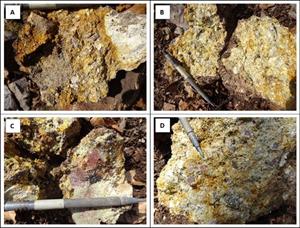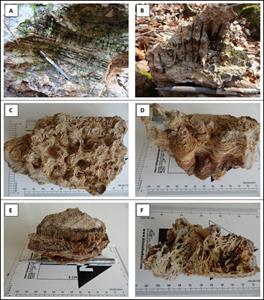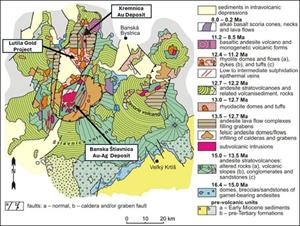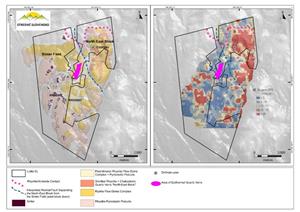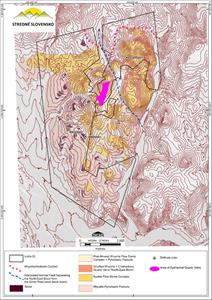
BULGOLD Extends the Occurrence of Epithermal Quartz Veins to 1.2KM of Strike Length Within the Sinter Field on the Lutila Gold Project
/EIN News/ -- TORONTO, May 12, 2025 (GLOBE NEWSWIRE) -- BULGOLD Inc. (TSXV: ZLTO) (the “Company” or “BULGOLD”) is pleased to announce the results of recent prospecting activity on the Lutila Gold Project (the “Property”), Slovakia. This information has now been validated and incorporated into the Company’s database. The Lutila exploration licence covers an area of 32.2km2 and is prospective for quartz-adularia epithermal gold mineralisation.
1. Highlights
-
Recent prospecting activity on the Horna Klapa section of Rhyolite Ridge, has led to the Company extending the occurrence of quartz vein material to over 1.2km in strike length which clearly indicates that this north-east striking portion of the ridge remains strongly prospective for gold mineralisation within epithermal quartz veins at depth below the ridgeline.
-
Within the currently defined strike length of 1.2km, the Company has now established quartz lattice bladed textures, which indicate clear evidence of boiling, over a distance 0.7km.
-
Additionally, the Company has uncovered the presence of what appears to be a medieval exploration gallery (‘pre-gunpowder’ era) which seems to drive towards the ridge line and contains altered pyroclastic rocks together with occasional epithermal quartz vein float within the associated waste piles.
-
Further field review of the Horna Klapa sinter terraces located proximal to this section of Rhyolite Ridge has revealed the presence of geyserite textures within outcropping sinter deposits; these textures indicate proximity to an “upflow zone” i.e., vent, geyser or hot spring.
-
During 2024, prospecting activity led to the discovery of epithermal quartz vein material on the highest peak within the Sinter Field; located 2.7km north along Rhyolite Ridge from RRDD001 and RRDD002 and 1.7km south west from CVDD001. This was the first time that epithermal quartz veins have been recognised within the Sinter Field and validate the Company’s exploration model.
-
The Lutila Gold Project is located favourably between two of the largest Au-Ag epithermal systems within the Central Slovakia Volcanic Field, the Kremnica gold deposit and the Banska Štiavnica gold-silver ore field, which, collectively, have produced significant amounts of precious metals over many centuries.
-
Exploration target: underground, high-grade gold (Au) ± silver (Ag) quartz veins.
Quote from the President & CEO, Mr Sean Hasson:
“There is now very little ambiguity in relation to the location of these epithermal quartz vein pieces as they sit on and just off the sides of the highest elevation section of Rhyolite Ridge. This means that they cannot be derived from any other portion of the property.
The textures of these epithermal quartz vein pieces indicate that they formed at a high level within the vein system and the nearby Horna Klapa sinter terrace also suggests that the current level of exposure is close to or at the paleosurface therefore indicating that the vein system is in place at depth below the ridgeline with minimal erosion responsible for the current distribution of epithermal quartz vein pieces.
When exploring for quartz-adularia vein systems it is critical to a) recognise where one sits within the system and b) to find one vein and then look for more, but perhaps more importantly from a capital allocation perspective it is crucial to determine where the highest probability of success lies as early as possible within the exploration programme i.e., where is the ‘engine room’ that will drive the project’s economics.
The BULGOLD exploration team believes that the Horna Klapa section of Rhyolite Ridge provides the Company with that level of probability. With that in mind, the Company continues to evaluate a number of options to progress the discovery process on the Lutila Gold Project.”
2. Epithermal Quartz Veins within the Sinter Field (Horna Klapa Target Area)
During 2024, prospecting following the completion of exploration drilling led to the discovery of epithermal quartz veins on and just below the equal highest peak (687mRL) within the Sinter Field. The BULGOLD exploration team has recently returned from the field where, due to good early Spring conditions, they were able to continue prospecting the Horna Klapa section of Rhyolite Ridge. The quartz vein material is now located 20-60m vertically above and 0.5-1km north-east from the nearest outcropping sinter terrace; the Horna Klapa sinter terrace. Sinters form at the paleo-water table, while epithermal quartz veins form beneath the paleo-water table (See Figures 1, 8, 9 & 10).
The epithermal quartz vein fragments continue to represent the high-level expression of an upflow zone located beneath this +1,400m portion of Rhyolite Ridge, where the overall strike of the ridge abruptly changes from a north-south to a north-east orientation. The vein pieces are dominated by low temperature, low fluid-flux textures and are commonly coarsely banded chalcedonic quartz with zones of quartz lattice bladed textures which indicate that boiling has occurred. Minor included fragments of rhyolite rock within the vein pieces clearly indicates that the veins formed within rhyolite rock. They are strongly anomalous for antimony (average of 122g/t Sb) with very low levels of Au, Ag and As (See Figures 2 & 3).
Additionally, a medieval exploration gallery was discovered on the eastern side of the Horna Klapa ridgeline located approximately 80m below the equal highest peak. It is believed that this mining activity was carried out in the ‘pre-gunpowder’ era (pre-1627) and was exploratory in nature and designed to access rocks below the ridgeline. The Company speculates that they may have been following up on the epithermal quartz vein float in the area and wished to assess the hydrothermal system at a lower level by driving a horizontal exploration gallery. The Company found clay-altered rhyolite pyroclastic rocks in proximity to the working (see Figure 4) and it should be noted that there are no outcropping altered rhyolite rocks in the vicinity (even though there is abundant rhyolite rock outcrop immediately above the working); minor epithermal quartz vein float was also found in the area.
Correction: The Company previously reported on the 14th November 2024 that an area of ancient mining had been discovered on the north-east end of the Horna Klapa ridgeline. Follow-up assessment of this area now leads the Company to agree that it is most likely a landslide conditioned by bentonised perlite at the margin of a rhyolite cryptodome (pers. Comms. Lexa, J. 2024). Additionally, the Company has found and sampled altered rhyolite pyroclastic material from this area (see Figure 5).
Historic gold exploration within the Lutila Gold Project has been ongoing for centuries given its location immediately south and along strike from the Kremnica gold deposit, which has been mined for approximately 1,000 years, and in that time, this is the first recorded occurrence of epithermal quartz veins within the Sinter Field. The Company has drill tested Rhyolite Ridge 2.7km south of this location and used the occurrence and distribution of outcropping sinters to guide such drilling efforts. It is now clear to the Company that future exploration drilling should take place within this +1,400m portion of Rhyolite Ridge where epithermal quartz veins are found at surface together with medieval exploration activity which provide indirect evidence for the presence of epithermal veins at depth beneath the ridgeline where they may have been deposited within an upflow zone.

Figure 1. The newly extended location of the area of epithermal quartz vein material on the Horna Klapa portion of Rhyolite Ridge overlain on historic Sb soil geochemistry with 2m contours derived from LIDAR. VQZ=Vein Quartz, LB=lattice bladed textures present, CRB=chalcedonic veinlets within rhyolite rock, ALT_VOL=altered rhyolite rock.

Figure 2. Field and slabbed examples of epithermal quartz veins from the north-east trending, +1,400m long Horna Klapa portion of Rhyolite Ridge. (A) Poorly developed crustiform-colloform vein piece (45532); (B) Low temperature chalcedonic quartz with included fragments of rhyolite rock (45533); (C) Massive chalcedonic quartz with included fragments of spherulitic rhyolite (45534); (D) Typical low temperature textures reflecting a low fluid-flux environment of formation within the upper levels of the upflow zone (45538).

Figure 3. Slabbed examples of epithermal quartz veins from the north-east trending, +1,400m long Horna Klapa portion of Rhyolite Ridge. (A) Coarse chalcedonic banding with minor quartz lattice bladed bands (45527); (B) Coarse quartz lattice bladed textures in chalcedonic quartz vein (45535); (C) Coarse chalcedonic banding with minor quartz lattice bladed bands (45536); (D) Coarse chalcedonic banding with minor quartz lattice bladed bands (95804); (E) & (F) Coarse chalcedonic banding with quartz lattice bladed section after carbonate indicating that boiling has taken place (45537).

Figure 4. (A), (B), (C) & (D): Examples of smectite ± zeolite altered rhyolite pyroclastic rocks which were excavated from the probable medieval exploration gallery waste dump.

Figure 5. Hydrothermally altered rhyolite pyroclastic rock from the area of the exposed cryptodome including a chalcedonic veinlet with finely disseminated marcasite in the far-right piece (above scribe end), 506g/t As, 107g/t Sb.
3. The Horna Klapa Sinter Terrace
Further field review was undertaken within the Horna Klapa sinter terrace which is located to the immediate south-west of the Horna Klapa portion of Rhyolite Ridge which contains the epithermal quartz vein pieces (see Figure 1). The sinter terrace is a significant geological feature on the property and contains multiple stacked terraces over approximately 250m of elevation, starting immediately below the named Horna Klapa peak (687mRL) and extending 1.3km towards the Kopernica potok (stream) located downhill and to the west.
Sinters commonly form proximal to upflow zones in which quartz-adularia epithermal veins may have formed at depth nearby. The Company has now clearly established that geyserite textures are present within the Horna Klapa sinter terrace (see Figure 6). These textures form in response to hot, deeply derived, near neutral, alkali-chloride waters intersecting the earth’s surface at or near the water table surface in the form of vents, geysers or hot springs. They are diagnostic textures and are commonly recognised today around active geothermal fields e.g., Yellowstone.
More importantly, geyserite textures form from geothermal waters which are being expelled from the upflow zone or the open space fault structures that are controlling the permeability fabric and allowing this near-boiling water to reach surface.
Taken in conjunction with the occurrence and distribution of epithermal quartz vein material found on the nearby Horna Klapa portion of Rhyolite Ridge, then the occurrence of geyserite textures provides additional support to the Company’s exploration model for the Lutila Gold Project i.e., there may not only be a spatial relationship but also a genetic relationship between the Horna Klapa sinter terrace and the nearby epithermal quartz veins.

Figure 6. Field examples of geyserite from the Horna Klapa sinter terrace. (A) Nodular geyserite in outcrop; (B) Nodular geyserite; (C) Nodular geyserite in plan view; (D) Nodular geyserite; (E) Delicate splash textures related to vent, geyser or hot spring proximity; (F) Splash textures related to vent, geyser or hot spring proximity.
4. Discussion
The Lutila Gold Project is located favourably between two of the largest Au-Ag epithermal systems within the Central Slovakia Volcanic Field, the Kremnica gold deposit and the Banska Štiavnica gold-silver ore field, which collectively, have produced significant amounts of precious metals over many centuries.
The Property is located 5km south, along strike and within the same volcanic depression that hosts the historic quartz-adularia Kremnica gold mine (current JORC (2012) mineral resource estimate of M&I: 36.9Mt @ 1.36g/t Au (1.6Moz Au) and Inf: 31.5Mt @ 1.07g/t Au (1.1Moz Au))1. Historic gold production is estimated by Finka (1995) to be 1.48Moz. According to Kodera (2005) the Banska Štiavnica ore field has produced 2.6Moz Au and 129Moz Ag from the early middle ages until the twentieth century
This is not a mineral reserve or mineral resource that has been prepared in compliance with the requirements of National Instrument 43-101. The technical and scientific information disclosed from neighboring properties does not necessarily apply to the Lutila Gold Project. The current JORC (2012) mineral resource estimate consists of: Measured 24.6Mt @ 1.46g/t Au, Indicated 12.3Mt @ 1.15g/t Au and Inferred 31.5Mt @1.07g/t Au. Source: Metals Tech Limited, ASX Release, 8th May 2023 (https://wcsecure.weblink.com.au/pdf/MTC/02663482.pdf).
The fact that low to intermediate sulfidation Au-Ag epithermal veins are intimately associated with rhyolite volcanism during the period 12.4 – 11.2Ma underpins the Company’s exploration model.

Figure 7. Regional geological setting of the Lutila Gold Project in relation to adjacent ore districts within the Central Slovakia Volcanic Field (after Kodera et al, 2014).
At the nearby Kremnica gold deposit, which is hosted in andesite volcanic rocks, rhyolite dykes are intimately associated with and often well mineralised where they are cross-cut, or run parallel to quartz-adularia veins, thus indicating that extrusive rhyolite volcanism was likely a pre-mineral event. Historic exploration drilling on the property has indicated that andesite volcanic rocks are present below the exposed rhyolite flow dome complexes and their associated pyroclastic products within the area of the North East Block, and it is likely that andesite volcanic rocks are present beneath the rhyolite and lacustrine sedimentary rock stratigraphy currently determined within the Sinter Field by BULGOLD drilling. It should be noted that the formation of a significant epithermal system within the property is somewhat independent of host rock given that the formation of low sulfidation epithermal vein systems are coeval with rhyolite volcanism.
Historic soil sampling has outlined a significant, +7km long, paleo-geothermal system as defined by arsenic and antimony geochemistry (see Figures 8 & 9). Historic and the Company’s rock chip sampling, which is biased to the North East Block, has shown that surface gold grades increase in value toward lower elevations, which is in line with the Company’s current geological model. Historic exploration drilling, which is also restricted to the North East Block, has shown that there are anomalous gold grades within the rhyolite flow dome complexes and their pyroclastic products on either flank of the Čertov vrch target area which is centred on the Čertov vrch peak (748mRL).
- Historic rock chip sampling, which is limited to the North East Block, has shown that surface gold grades increase in value (up to 4.44g/t Au) towards lower elevations.
- Historic exploration drilling, which is also restricted to the North East Block, recorded a best intersection of 26.2m @ 0.91g/t Au (from 97m).
-
Geyserite textures have also been recognised within the sinter terraces located in the west of the property (Slaska) where historic soil sampling was not undertaken.
The Company believes that the Lutila Gold Project reflects a continuation of the same volcanic depression (that hosts the Kremnica gold mine), which has been downfaulted, creating a preserved graben of rhyolite flow domes complexes and their pyroclastic products together with a very large sinter field.
Field work completed by the Company during 2024 and 2025, in conjunction with a thorough review of the historic exploration data (primarily within the North East Block), taken together with the extensive Sinter Field, which reflects the position of the Miocene paleosurface and is an indication of boiling at depth within an epithermal system which, if present, is preserved from erosion, would tend to strongly support the Company’s exploration model. The discovery of epithermal quartz vein material with a current strike length of 1.2km within the Sinter Field and the associated area of the medieval exploration gallery have now shown, for the first time, that the Lutila Gold Project remains a highly prospective property for the discovery of epithermal quartz-adularia vein systems.
5. About the Slovak Republic
- EU and NATO member since 2004.
- Eurozone member since 2009.
- Established mining industry, clearly defined mining legislation.
- No restrictions on foreign ownership.
- 21% corporate tax rate.
- 5% NSR for gold and silver.
- The use of cyanide for extractive purposes has been prohibited since 2014.
- Low-cost profiles, skilled local workforce.
- Exploration licences can be held for a 10-year period (4+4+2).
References:
Finka, O., 1995. Zlatá Kremnica: Tisícročná história baníctva, Neografia vydavateľstvo, Monografie 71 pages (in Slovak).
Kodera P., Lexa J., Rankin AH., Fallick AE., 2005. Epithermal gold veins in a caldera setting: Banská Hodruša, Slovakia. Mineralium Deposita. 39: 921-943.
Kodera P., Lexa J., Fallick AE., Walle M., Biron A., 2014. Hydrothermal fluids in epithermal and porphyry Au deposits in the Central Slovakia Volcanic Field. Geological Society, London, Special Publications 2014, v.402; p177-206.
About BULGOLD Inc.
BULGOLD is a gold exploration company focused on the exploration and development of mineral exploration projects in Central and Eastern Europe. The Company controls 100% of three quality quartz-adularia epithermal gold projects located in the Slovakian and Bulgarian portions of the Western Tethyan Belt: the Lutila Gold Project, the Kostilkovo Gold Project and the Kutel Gold Project. Management of the Company believes that its assets show potential for high-grade, good-metallurgy, low-sulfidation epithermal gold mineralisation.
Historic Sampling and Drilling Data and Information
The historical sampling and drilling data and information disclosed in this news release is related to historical exploration results. The reader is cautioned that the historical sampling and drilling data and information are based on prior data and reports previously prepared by third parties without the involvement of the Company. Historic grab or rock sampling are selected samples and may not represent the true underlying mineralization. Information has been sourced from the Slovak Geological Survey in reports 83971 (December 1997) and 92416 (February 2013). BULGOLD has not undertaken any independent investigation of the historical sampling and drilling data and information, nor has it independently analyzed the results of the historical sampling and drilling exploration work in order to verify the results. The reader is cautioned not to treat them, or any part of them, as current due to the fact that a qualified person has not done sufficient work to verify the results and that they may not form a reliable guide to future results. No independent quality assurance/quality control protocols are known for these historic samples and drill holes and therefore the analytical results, data and information may be unreliable. BULGOLD considers the historical sample and drill data and information to be relevant as BULGOLD is using this data and information, in conjunction with the sampling conducted by BULGOLD, as a guide to plan its exploration program for the Lutila Gold Project. BULGOLD’s current exploration work includes verification of the historical data and information through further exploration.
Sampling, Analysis and QAQC of Exploration Drill Core Samples
Most exploration diamond drill holes are collared with PQ size, continued with HQ, and are sometimes finished with NQ. Triple tube core barrels and short runs are used whenever possible to improve recovery. All drill core is cut lengthwise into two halves using a diamond saw; the right-hand half looking downhole is sampled for assaying and the other half is retained in core trays. The common length for sample intervals within mineralized zones is one metre. Weights of drill core samples range from three to eight kilograms (“kg”), depending on the size of core, rock type, and recovery. A numbered tag is placed into each sample bag, and the samples are grouped into batches for laboratory submissions.
Diamond drill core samples are shipped to SGS Burgas, Bulgaria. Quality control samples, comprising certified reference materials, blanks, and field duplicates, are inserted into each batch of samples and locations for crushed duplicates and pulp replicates are specified. All drill core and quality control samples are tabulated on sample submission forms that specify sample preparation procedures and codes for analytical methods. For internal quality control, the laboratory includes its own quality control samples comprising certified reference materials, blanks and pulp duplicates. All QAQC monitoring data are reviewed, verified and signed off by the Company. Chain of custody records are maintained from sample shipments to the laboratory until analyses are completed and remaining sample materials are returned to the Company. The chain of custody is transferred from the Company to SGS at the laboratory door.
At the SGS Burgas laboratory, the submitted core samples are dried at 105°C for a minimum of 12 hours, and then jaw crushed to ~80% passing 2-6mm. Sample preparation duplicates are created by riffle splitting crushed samples on a 1-in-20 basis. Larger samples are riffle split prior to pulverizing, whereas smaller samples are pulverized entirely. Pulverizing specifications are 90% passing 75 microns. Gold analyses are done using a conventional 50-gram fire assay and AAS finish. Multi-element analyses for 36 elements are done using a four-acid digestion and an ICP-OES finish.
BULGOLD’s issued and outstanding shares are 27,597,928 of which approximately 40.3% are held by Founders, Directors and Management. Additional information about the Company is available on BULGOLD’s website (www.BULGOLD.com) and on SEDAR+ (www.sedarplus.ca).
Qualified Person
The scientific and technical information in this news release was reviewed and approved by Mr Sean Hasson, a Qualified Person as defined by National Instrument 43-101 and President and Chief Executive Officer to the Company.
Neither TSX Venture Exchange nor its Regulation Services Provider (as that term is defined in the policies of the TSX Venture Exchange) accepts responsibility for the adequacy or accuracy of this release.
Cautionary Statement Regarding Forward-Looking Information
This press release contains forward‐looking statements and forward‐looking information within the meaning of applicable securities laws (collectively, “forward-looking statements”). These statements relate to future events or future performance and include statements relating to the exploration and drilling plans of the Company and the timing thereof; the Lutila Gold Project and the status of the Lutila Gold Project as a strong early-stage gold project in Europe; the Kremnica gold mine and the reason for the Kremnica gold mine being exploited over a long period of time; the Lutila Gold Project reflecting a continuation of the same Kremnica volcanics; the Company’s exploration model for the Lutila Gold Project’ the potential of the Lutila Gold Project to benefit the Company’s stakeholders; the mineralised inventory within the Kremnica deposit through time; the targeted upflow zone drilling at Rhyolite Ridge target; and the potential drill success on the Rhyolite Ridge target area and the impact thereof on future exploration. All statements other than statements of historical fact may be forward‐looking statements or information. The forward‐looking statements and information are based on certain key expectations and assumptions made by management of the Company. Although management of the Company believes that the expectations and assumptions on which such forward-looking statements and information are based are reasonable, undue reliance should not be placed on the forward‐looking statements and information since no assurance can be given that they will prove to be correct.
Forward-looking statements and information are provided for the purpose of providing information about the current expectations and plans of management of the Company relating to the future. Readers are cautioned that reliance on such statements and information may not be appropriate for other purposes, such as making investment decisions. Since forward‐looking statements and information address future events and conditions, by their very nature they involve inherent risks and uncertainties. Actual results could differ materially from those currently anticipated due to a number of factors and risks, including the inherent uncertainty of mineral exploration; risks related to title to mineral properties; and changes in laws or regulations, including environmental laws and regulations; and credit, market, currency, operational, commodity, geopolitical, liquidity and funding risks generally, including changes in economic conditions, interest rates or tax rates and general market conditions. Accordingly, readers should not place undue reliance on the forward‐looking statements and information contained in this press release. Readers are cautioned that the foregoing list of factors is not exhaustive. The forward‐looking statements and information contained in this press release are made as of the date hereof and no undertaking is given to update publicly or revise any forward‐looking statements or information, whether as a result of new information, future events or otherwise, unless so required by applicable securities laws. The forward-looking statements and information contained in this press release are expressly qualified by this cautionary statement.
For further information, please contact:
BULGOLD Inc.
Sean Hasson, President and Chief Executive Officer
Telephone: +359 887 560 545
Email: sean.hasson@BULGOLD.com
Website: www.BULGOLD.com

Figure 8. The Lutila Exploration Licence – Geology & Antimony (Sb) Soil Geochemistry.

Figure 9. The Lutila Exploration Licence – Geology & Arsenic (As) Soil Geochemistry.

Figure 10. Lutila Gold Project – Geology.
Photos accompanying this announcement are available at https://www.globenewswire.com/NewsRoom/AttachmentNg/eb4dddc4-d13f-44e7-99d0-0aea5306f370
https://www.globenewswire.com/NewsRoom/AttachmentNg/39fb550d-3296-4353-b5dd-068a45e89f0b
https://www.globenewswire.com/NewsRoom/AttachmentNg/f4c2c956-3f3a-46e5-bd2c-20858d1a4550
https://www.globenewswire.com/NewsRoom/AttachmentNg/12a5ce81-dc78-4bed-a387-4034dbc7ca4d
https://www.globenewswire.com/NewsRoom/AttachmentNg/91b625b1-d7f7-4a31-a9a8-4418c2841a7c
https://www.globenewswire.com/NewsRoom/AttachmentNg/16998162-4279-4f8e-b61b-2a7820715fa9
https://www.globenewswire.com/NewsRoom/AttachmentNg/3cc6ceb7-7e36-423a-b8b2-1c8a72326130
https://www.globenewswire.com/NewsRoom/AttachmentNg/719e58fd-82a2-47fa-a7c1-6668ad570dc3
https://www.globenewswire.com/NewsRoom/AttachmentNg/55489c1c-fb06-44e9-a5d9-704aa30f84aa
https://www.globenewswire.com/NewsRoom/AttachmentNg/1f074d3a-a9a6-4458-8843-59c5ee8e4d20

Figure 1.
The newly extended location of the area of epithermal quartz vein material on the Horna Klapa portion of Rhyolite Ridge overlain on historic Sb soil geochemistry with 2m contours derived from LIDAR. VQZ=Vein Quartz, LB=lattice bladed textures present, CRB=chalcedonic veinlets within rhyolite rock, ALT_VOL=altered rhyolite rock.
Figure 2.
Field and slabbed examples of epithermal quartz veins from the north-east trending, +1,400m long Horna Klapa portion of Rhyolite Ridge. (A) Poorly developed crustiform-colloform vein piece (45532); (B) Low temperature chalcedonic quartz with included fragments of rhyolite rock (45533); (C) Massive chalcedonic quartz with included fragments of spherulitic rhyolite (45534); (D) Typical low temperature textures reflecting a low fluid-flux environment of formation within the upper levels of the upflow zone (45538).
Figure 3.
Slabbed examples of epithermal quartz veins from the north-east trending, +1,400m long Horna Klapa portion of Rhyolite Ridge. (A) Coarse chalcedonic banding with minor quartz lattice bladed bands (45527); (B) Coarse quartz lattice bladed textures in chalcedonic quartz vein (45535); (C) Coarse chalcedonic banding with minor quartz lattice bladed bands (45536); (D) Coarse chalcedonic banding with minor quartz lattice bladed bands (95804); (E) & (F) Coarse chalcedonic banding with quartz lattice bladed section after carbonate indicating that boiling has taken place (45537).
Figure 4.
(A), (B), (C) & (D): Examples of smectite ± zeolite altered rhyolite pyroclastic rocks which were excavated from the probable medieval exploration gallery waste dump.
Figure 5.
Hydrothermally altered rhyolite pyroclastic rock from the area of the exposed cryptodome including a chalcedonic veinlet with finely disseminated marcasite in the far-right piece (above scribe end), 506g/t As, 107g/t Sb.
Figure 6.
Field examples of geyserite from the Horna Klapa sinter terrace. (A) Nodular geyserite in outcrop; (B) Nodular geyserite; (C) Nodular geyserite in plan view; (D) Nodular geyserite; (E) Delicate splash textures related to vent, geyser or hot spring proximity; (F) Splash textures related to vent, geyser or hot spring proximity.
Figure 7.
Regional geological setting of the Lutila Gold Project in relation to adjacent ore districts within the Central Slovakia Volcanic Field (after Kodera et al, 2014).
Figure 8.
The Lutila Exploration Licence – Geology & Antimony (Sb) Soil Geochemistry.
Figure 9.
The Lutila Exploration Licence – Geology & Arsenic (As) Soil Geochemistry.
Figure 10.
Lutila Gold Project – Geology.
Distribution channels: Banking, Finance & Investment Industry, Mining Industry ...
Legal Disclaimer:
EIN Presswire provides this news content "as is" without warranty of any kind. We do not accept any responsibility or liability for the accuracy, content, images, videos, licenses, completeness, legality, or reliability of the information contained in this article. If you have any complaints or copyright issues related to this article, kindly contact the author above.
Submit your press release





